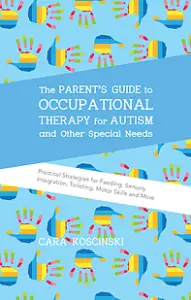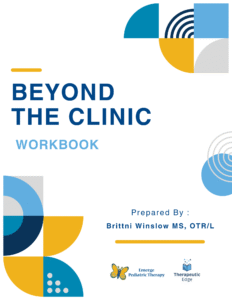We all know someone who doesn’t like certain foods or doesn’t like wearing tags on clothing. Even though Sensory Processing Disorder has not yet made that ‘official’ status in the DSM (the diagnostic manual that doctors use to name disorders), we know it’s REAL! Ask anyone who craves deep pressure, cringes at the sound of someone else chewing, or hates tags if they are ‘faking’ it and you might get yourself a very dirty look! In fact, Sensory Processing Disorder is so real that it can debilitate anyone in a snap. Think about a fire alarm going off and the utter panic elicited by one single sound. The fact is, our bodies are designed to protect us from perceived danger and our very survival depends on it!
FREE download at the end of this post! Use it to help understand sensory activity ideas.
What ARE the eight senses?
1) Vision or sight
We see things with our eyes and an entire center of the brain is designated to process and make sense of what we see. Sometimes, we react reflexively to light (pupils constrict or dilate), and other times, we need a few seconds to process what we are seeing. Kids with sensory difficulties often enjoy looking at things very closely, flicking their fingers in front of their eyes, or turning their heads to look out of the corner of their eye.
2) Smell or olfactory
Our nose is intimately connected with our brain. In fact, the olfactory lobe of the brain is RIGHT near the nose! Smell is even directly connected to our brain’s memory areas so that a certain smell can immediately trigger powerful memories and emotions. Some children vomit thinking about the smell of certain things. Others are seen sniffing items constantly.
3) Taste or oral
Everyone who has experienced a sinus infection knows that if you cannot taste, it’s not worth eating! We all prefer salty, sweet, sour, hot, spicy, and other foods. Our mouth is equipped with receptors that allow us to enjoy eating. Our society has traditions surrounding mealtimes and one of the most stressful types of sensory integration dysfunction involves feeding or oral-sensitivity!
4) Hearing or Auditory
 Read the Parent’s Guide to OT for Autism & Special Needs……contains sensory, behavior, hair washing, dressing, motor skills and more! Activities you can do with your child immediately.
Read the Parent’s Guide to OT for Autism & Special Needs……contains sensory, behavior, hair washing, dressing, motor skills and more! Activities you can do with your child immediately.
We respond to our environment effectively as we process sound. An infant in the womb knows her mother’s voice and responds to it. As we learn about our surroundings, we understand that sounds can mean danger. For instance, high-frequency sounds give us detail about information around us and low-frequency sounds (thunder or booms) alert us to possible danger. Many people with sensory integration difficulty experience hypersensitivity to sound. One of our favorite ways to help those individuals is via
a product called Sound-Eaze. It contains common sounds people fear and pairs them with rhythm and vocals to nursery rhymes so that children can control sounds they otherwise cannot. There’s even a
School-Eaze version.
5) Touch or Tactile
Receptors in the skin give us information about light touch, heat, cold, rubbing or brushing, and so many more. We are sensitive to our clothing and feel the pinch of tags, seams, and other itchy fabrics. The dysfunction comes in when we cannot ‘accommodate’ or get used to those irritations. So, a person who has extra sensitivity in the tactile area does not accommodate to the tag…..it’s itchy and even painful and does not stop until the shirt is removed! Can you imagine feeling your tag ALL day and then trying to work a business deal or form a presentation if your tag is pinching you like a bee’s bite? It would be terrible!!
6) Proprioception or Position
This is the body’s sense of position or joint position. Receptors embedded in our joints and limbs give us information about where we are in space. This is critical as we function so that we can have smooth and coordinated movements. We need to know how far to reach for our pencil in order to effectively grasp it. We do not need to look at our legs as we walk, we just know they are on the ground and then move them reciprocally to walk. We take this sense for granted. Consider driving. We are looking at the road but know where the gas, brake, steering wheel, and signals are and can move our body to use them without much thought. The process really is automatic and smooth. If you’re technical, the spinocerebellar tract in the spinal cord is the highway to our cerebellum and all of this (among other processes) make a nice and smooth system.
Kids with issues processing in this area are often noted to crash into people or furniture. Others avoid touch or become upset when accidentally touched while standing in line or in the classroom.
7) Vestibular
One of the reasons I chose to write this post today is because I’ve had a sinus infection all week. I’ve been dizzy and nauseated for a while now and I’m quite irritated! What if someone was always feeling dizzy and queasy due to ineffective vestibular processing. I bet they would feel cranky too.
The vestibular system includes parts of our inner ear and brain that help control balance and eye movements. Here’s a link to the
Vestibular Disorders Association. It’s a very helpful website. Clumsiness, vision difficulties, coordination, and balance issues are common with vestibular dysfunction.
8) Interoception
While researching this area for my newest book
I’ve learned that we are who we are because of our nature and our experiences. Each shapes us and every time we form a memory, it fits into our very being due to how we experience it. Our internal organs have receptors that regulate internal processes such as heart rate, hunger, sexual drive, thirst, urge to use the toilet, fear, and so much more! Interoception is the ‘who’ we are and ‘how’ we each see the world through our own eyes.
I offer a FREE handout for everyone on my e-mail list. Here’s the link to get yours:
GET MY SPD DOWNLOAD




